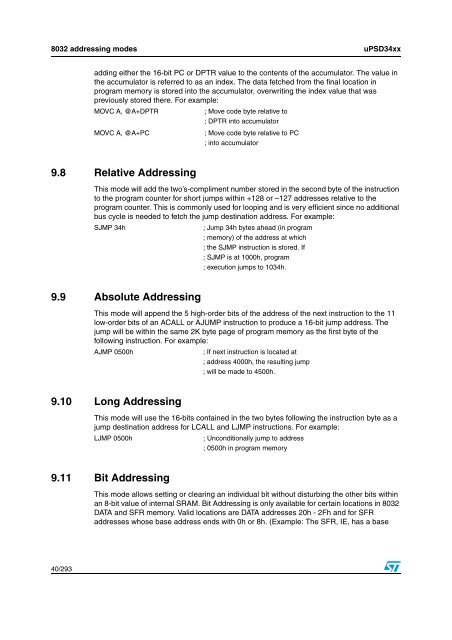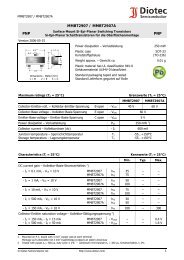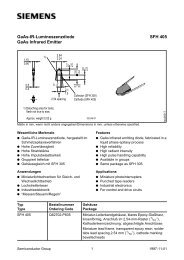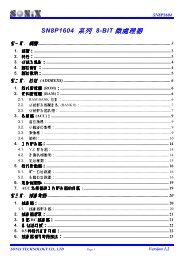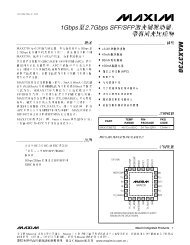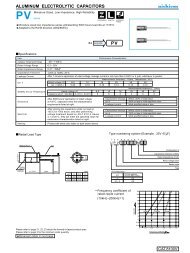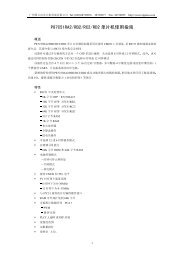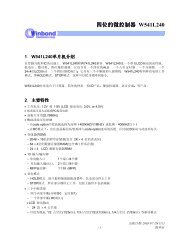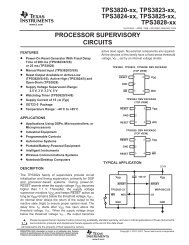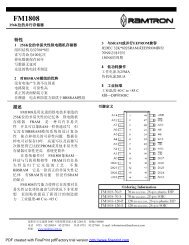- Page 1 and 2: Features summary uPSD34xx Turbo Plu
- Page 3 and 4: uPSD34xx Contents Contents 1 Summar
- Page 5 and 6: uPSD34xx Contents 18.3 Connecting e
- Page 7 and 8: uPSD34xx Contents 27.5 Timer mode .
- Page 9 and 10: uPSD34xx Summary description 1 Summ
- Page 11 and 12: uPSD34xx Pin descriptions 2 Pin des
- Page 13 and 14: uPSD34xx Pin descriptions Table 2.
- Page 15 and 16: uPSD34xx Pin descriptions Table 2.
- Page 17 and 18: uPSD34xx Hardware description 3 Har
- Page 19 and 20: uPSD34xx Memory organization 4 Memo
- Page 21 and 22: uPSD34xx Memory organization 4.2.1
- Page 23 and 24: uPSD34xx 8032 MCU core performance
- Page 25 and 26: uPSD34xx 8032 MCU core performance
- Page 27 and 28: uPSD34xx MCU module description 6 M
- Page 29 and 30: uPSD34xx 8032 MCU registers the B R
- Page 31 and 32: uPSD34xx Special function registers
- Page 33 and 34: uPSD34xx Special function registers
- Page 35 and 36: uPSD34xx Special function registers
- Page 37 and 38: uPSD34xx Special function registers
- Page 39: uPSD34xx 8032 addressing modes 9.4
- Page 43 and 44: uPSD34xx uPSD34xx instruction set s
- Page 45 and 46: uPSD34xx uPSD34xx instruction set s
- Page 47 and 48: uPSD34xx Dual data pointers 11 Dual
- Page 49 and 50: uPSD34xx Dual data pointers LOOP: M
- Page 51 and 52: uPSD34xx Debug unit up to VCC as de
- Page 53 and 54: uPSD34xx Interrupt system If an int
- Page 55 and 56: uPSD34xx Interrupt system 13.1 Indi
- Page 57 and 58: uPSD34xx Interrupt system Table 18.
- Page 59 and 60: uPSD34xx MCU clock generation 14 MC
- Page 61 and 62: uPSD34xx MCU clock generation Figur
- Page 63 and 64: uPSD34xx Power saving modes 15 Powe
- Page 65 and 66: uPSD34xx Power saving modes Table 2
- Page 67 and 68: uPSD34xx Oscillator and external co
- Page 69 and 70: uPSD34xx I/O ports of mcu module 17
- Page 71 and 72: uPSD34xx I/O ports of mcu module CP
- Page 73 and 74: uPSD34xx I/O ports of mcu module Ta
- Page 75 and 76: uPSD34xx I/O ports of mcu module ou
- Page 77 and 78: uPSD34xx I/O ports of mcu module Ta
- Page 79 and 80: uPSD34xx MCU bus interface A[10:8]
- Page 81 and 82: uPSD34xx MCU bus interface Table 37
- Page 83 and 84: uPSD34xx Supervisory functions 19 S
- Page 85 and 86: uPSD34xx Supervisory functions To p
- Page 87 and 88: uPSD34xx Standard 8032 timer/counte
- Page 89 and 90: uPSD34xx Standard 8032 timer/counte
- Page 91 and 92:
uPSD34xx Standard 8032 timer/counte
- Page 93 and 94:
uPSD34xx Standard 8032 timer/counte
- Page 95 and 96:
uPSD34xx Standard 8032 timer/counte
- Page 97 and 98:
uPSD34xx Standard 8032 timer/counte
- Page 99 and 100:
uPSD34xx Serial UART interfaces 21
- Page 101 and 102:
uPSD34xx Serial UART interfaces SM2
- Page 103 and 104:
uPSD34xx Serial UART interfaces 21.
- Page 105 and 106:
uPSD34xx Serial UART interfaces Fig
- Page 107 and 108:
uPSD34xx Serial UART interfaces Fig
- Page 109 and 110:
uPSD34xx Serial UART interfaces Fig
- Page 111 and 112:
uPSD34xx IrDA interface 22 IrDA int
- Page 113 and 114:
uPSD34xx IrDA interface Table 51. B
- Page 115 and 116:
uPSD34xx I 2 C interface 23 I 2 C i
- Page 117 and 118:
uPSD34xx I 2 C interface A few thin
- Page 119 and 120:
uPSD34xx I 2 C interface 23.6 Gener
- Page 121 and 122:
uPSD34xx I 2 C interface 23.8 I 2 C
- Page 123 and 124:
uPSD34xx I 2 C interface Table 56.
- Page 125 and 126:
uPSD34xx I 2 C interface 23.12 I 2
- Page 127 and 128:
uPSD34xx I 2 C interface Table 62.
- Page 129 and 130:
uPSD34xx I 2 C interface Set global
- Page 131 and 132:
uPSD34xx I 2 C interface Else If mo
- Page 133 and 134:
uPSD34xx I 2 C interface Does statu
- Page 135 and 136:
uPSD34xx SPI (synchronous periphera
- Page 137 and 138:
uPSD34xx SPI (synchronous periphera
- Page 139 and 140:
uPSD34xx SPI (synchronous periphera
- Page 141 and 142:
uPSD34xx SPI (synchronous periphera
- Page 143 and 144:
uPSD34xx USB interface 25 USB inter
- Page 145 and 146:
uPSD34xx USB interface 25.1.2 Endpo
- Page 147 and 148:
uPSD34xx USB interface 25.2 Types o
- Page 149 and 150:
uPSD34xx USB interface Figure 53. C
- Page 151 and 152:
uPSD34xx USB interface Figure 54. F
- Page 153 and 154:
uPSD34xx USB interface Command Valu
- Page 155 and 156:
uPSD34xx USB interface Table 70. US
- Page 157 and 158:
uPSD34xx USB interface ● USB IN F
- Page 159 and 160:
uPSD34xx USB interface ● USB Glob
- Page 161 and 162:
uPSD34xx USB interface ● USB OUT
- Page 163 and 164:
uPSD34xx USB interface ● USB Cont
- Page 165 and 166:
uPSD34xx USB interface ● USB Endp
- Page 167 and 168:
uPSD34xx USB interface Bit Symbol R
- Page 169 and 170:
uPSD34xx USB interface ● USB Setu
- Page 171 and 172:
uPSD34xx Analog-to-digital converto
- Page 173 and 174:
uPSD34xx Analog-to-digital converto
- Page 175 and 176:
uPSD34xx Programmable counter array
- Page 177 and 178:
uPSD34xx Programmable counter array
- Page 179 and 180:
uPSD34xx Programmable counter array
- Page 181 and 182:
uPSD34xx Programmable counter array
- Page 183 and 184:
uPSD34xx Programmable counter array
- Page 185 and 186:
uPSD34xx PSD module 28 PSD module T
- Page 187 and 188:
uPSD34xx PSD module 28.1.5 SRAM pro
- Page 189 and 190:
uPSD34xx PSD module 28.1.11 OMCs sm
- Page 191 and 192:
uPSD34xx PSD module 28.1.16 Power m
- Page 193 and 194:
uPSD34xx PSD module Table 103. HDL
- Page 195 and 196:
uPSD34xx PSD module Figure 67. Mapp
- Page 197 and 198:
uPSD34xx PSD module 28.2.7 The VM r
- Page 199 and 200:
uPSD34xx PSD module Note: x = NA Th
- Page 201 and 202:
uPSD34xx PSD module Register Name P
- Page 203 and 204:
uPSD34xx PSD module Table 107. Flas
- Page 205 and 206:
uPSD34xx PSD module 28.5.7 Toggle f
- Page 207 and 208:
uPSD34xx PSD module attempted to pr
- Page 209 and 210:
uPSD34xx PSD module indicate when a
- Page 211 and 212:
uPSD34xx PSD module If a Suspend Se
- Page 213 and 214:
uPSD34xx PSD module The DPLD perfor
- Page 215 and 216:
uPSD34xx PSD module Figure 74. DPLD
- Page 217 and 218:
uPSD34xx PSD module Figure 75. DPLD
- Page 219 and 220:
uPSD34xx PSD module 28.5.28 Output
- Page 221 and 222:
uPSD34xx PSD module Native product
- Page 223 and 224:
uPSD34xx PSD module 28.5.32 OMC mas
- Page 225 and 226:
uPSD34xx PSD module 28.5.34 I/O por
- Page 227 and 228:
uPSD34xx PSD module Port Operating
- Page 229 and 230:
uPSD34xx PSD module Table 126. MCU
- Page 231 and 232:
uPSD34xx PSD module After PSDsoft E
- Page 233 and 234:
uPSD34xx PSD module Table 135. Latc
- Page 235 and 236:
uPSD34xx PSD module mode, making th
- Page 237 and 238:
uPSD34xx PSD module See Figure 85 f
- Page 239 and 240:
uPSD34xx PSD module if they are use
- Page 241 and 242:
uPSD34xx PSD module Figure 88. Port
- Page 243 and 244:
uPSD34xx PSD module register to “
- Page 245 and 246:
uPSD34xx PSD module 28.5.52 Automat
- Page 247 and 248:
uPSD34xx PSD module Figure 89. Auto
- Page 249 and 250:
uPSD34xx PSD module of PLD input tr
- Page 251 and 252:
uPSD34xx PSD module In PLD I/O mode
- Page 253 and 254:
uPSD34xx PSD module Figure 91. JTAG
- Page 255 and 256:
uPSD34xx PSD module TSTAT and TERR
- Page 257 and 258:
uPSD34xx PSD module Figure 95. Exam
- Page 259 and 260:
uPSD34xx AC/DC parameters 29 AC/DC
- Page 261 and 262:
uPSD34xx AC/DC parameters I CC (MCU
- Page 263 and 264:
uPSD34xx DC and AC parameters 31 DC
- Page 265 and 266:
uPSD34xx DC and AC parameters Idle
- Page 267 and 268:
uPSD34xx DC and AC parameters Table
- Page 269 and 270:
uPSD34xx DC and AC parameters Figur
- Page 271 and 272:
uPSD34xx DC and AC parameters Note:
- Page 273 and 274:
uPSD34xx DC and AC parameters Symbo
- Page 275 and 276:
uPSD34xx DC and AC parameters Figur
- Page 277 and 278:
uPSD34xx DC and AC parameters Table
- Page 279 and 280:
uPSD34xx DC and AC parameters Figur
- Page 281 and 282:
uPSD34xx DC and AC parameters Symbo
- Page 283 and 284:
uPSD34xx DC and AC parameters Table
- Page 285 and 286:
uPSD34xx Package mechanical informa
- Page 287 and 288:
uPSD34xx Important notes 34 Importa
- Page 289 and 290:
uPSD34xx Important notes implemente
- Page 291 and 292:
uPSD34xx Important notes 34.12 Inco
- Page 293:
uPSD34xx Please Read Carefully: Inf


